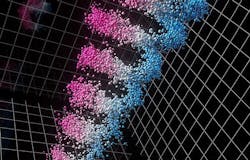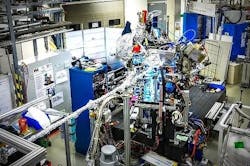Quantum ‘tornadoes’ experimentally shown within momentum space
A quantum “tornado” is a simplified term for an orbital vortex line, and work led by Maximilian Ünzelmann, a Complexity and Topology in Quantum Matter (ct.qmat) postdoctoral researcher at the Universities of Würzburg and Dresden in Germany, experimentally demonstrated electrons form these vortices within the momentum space of quantum semimetal tantalum arsenide (TaAs; see video).
Momentum space describes electron motion in terms of energy and direction—not a precise physical position. Position space is the realm where phenomena like water vortices or hurricanes occur and, until Ünzelmann and colleagues’ most recent work, quantum vortices within materials had only been observed within position space.
Quantum materials’ electronic structure is described within momentum space, in which each discrete point represents an electron wave spread over the entire crystal within position space. And for quantum materials, topological momentum space textures can occur with different shapes—such as charges/monopoles (hedgehogs) or whirls/vortices.
Topology is the basic quantum concept underlying the team’s work. Originally a mathematical concept, topology has evolved as a central concept for condensed matter physics—with a focus on quantum materials—during the past few decades.
“It describes nature in terms of geometrical shapes associated with integer quantum numbers—in terms of mathematics, like the number of holes within an object,” says Ünzelmann. “In our case, the ‘quantum tornado’ or the orbital momentum space vortex is a topological object with a well-defined quantum number, which winds around the vortex core.”
In 2021, Ünzelmann discovered orbital monopoles (charges) within the same topological quantum materials (TaAs). “These are zero-dimensional point-like structures,” he says. “And it inspired us to search for topological line features such as vortices/tornadoes.”
Several years prior to this, ct.qmat Cofounder Roderich Moessner theorized that a quantum tornado could form within momentum space—akin to a smoke ring (which is made of vortices). The problem? No one knew how to measure them.
The team’s experiments showed the quantum vortex is created by orbital momentum—electrons’ circular motion around atomic nuclei—and as soon as they saw signs that the predicted quantum vortices actually exist and could be measured, they reached out to Moessner and launched a joint project.
ARPES meets dicroism
How does the team’s topology-based method work? They combine angle-resolved photoemission spectroscopy (ARPES) with linear and circular dichroism to create dichroism ARPES—and image the winding atomic orbital angular momentum.
“Our method relies on the photoelectric effect—described by Albert Einstein,” explains Ünzelmann. “Electrons are emitted from sample surfaces upon light irradiation. And we detect the excited electrons as a function of energy and exit angle, so we can analyze the characteristic momentum-dependent intensities (when varying the light polarization).”
When carried out at soft x-ray photon energies, “dichroism ARPES allows us to reconstruct topological textures such as ‘orbital monopoles’ or, in our case, orbital vortices,” Ünzelmann says.
One of the challenges of using this method was to image a vortex-like object that occurs within three-dimensional (3D) momentum space and requires 3D imaging. “Soft x-ray dichroism ARPES lets us take measurements at different photon energies,” says Ünzelmann. “In general, this is a standard way to sweep through 3D momentum space. We’ve now shown that it does indeed allow us to address the 3D dichroism signal and, with it, the vortex.”
After the team analyzed the sample layer by layer, they stitched together individual images (akin to medical tomography) to reconstruct the 3D structure of the orbital angular momentum and confirm that electrons form vortices within momentum space.
Isn’t physics/science cool?
Not surprisingly, the coolest aspect of this work for Ünzelmann was actually observing the vortices within momentum space. “The fact that electronic wave functions form such textures within momentum space—and we can measure them—is really surprising and cool,” he says. “Who knows what other types of structures exist that we don’t know about? For the experimental core team of Hendrik Bentmann, Tim Figgemeier, and me, this observation of vortices was: ‘Wow—isn't physics/science cool?!’”
As far as what this means for quantum materials, “these methodological developments may allow us to find novel—so far completely unexplored—phases within quantum materials,” Ünzelmann says.
Orbitronics ahead
The team’s work is also intriguing for a more application-related research field: Orbitronics. “It aims to make use of the measured quantum degree of freedom in information technologies,” Ünzelmann says. “I leave the question of the ‘timeline to use’ to the specialists within this particular field because it’s all basic research at this point.”
Ünzelmann and colleagues are now exploring whether this class of materials and textures can indeed “show ‘orbitronic’ phenomena,” he adds. “Another goal is to apply our method to other classes of quantum materials, which are currently of interest within the scientific community, such as chiral materials and altermagnets.”
FURTHER READING
T. Figgemeier et al., Phys. Rev. X, 15, 011032 (Feb. 13, 2025); https://doi.org/10.1103/physrevx.15.011032.
About the Author
Sally Cole Johnson
Editor in Chief
Sally Cole Johnson, Laser Focus World’s editor in chief, is a science and technology journalist who specializes in physics and semiconductors.


